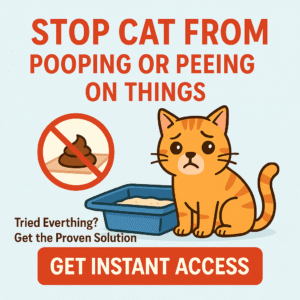Nothing disrupts your peace at home faster than a cat peeing where they shouldn’t—on rugs, furniture, or in corners around the house. If your cat is peeing inside the house instead of the litter box, it’s more than an inconvenience—it’s a cry for help. But once you understand the reasons behind the behavior, stopping it becomes easier than you think.
Why Is My Cat Peeing Inside the House?
Your cat is peeing in the house due to medical issues, stress, territorial behavior, or litter box aversion. It’s not defiance—it’s communication. Here’s how to decode it:
1. Medical Issues
Health problems can cause your cat to lose control or avoid the litter box because of pain.
- Urinary tract infections (UTIs) – cause painful urination and urgency
- Kidney disease or diabetes – increase urine volume and frequency
- Bladder stones or inflammation (FLUTD) – lead to accidents
- Constipation or arthritis – makes litter box trips painful
First step: Visit your vet to rule out or treat any medical causes.
2. Stress or Anxiety
Cats are creatures of routine. Even subtle stress can cause them to act out by urinating around the house.
- New pets, babies, or people in the home
- Moving, remodeling, or loud environments
- Changes in daily schedule or feeding times
Stress triggers marking behaviors or avoidance of the litter box. Help them feel secure again by reducing change and offering more safe spaces.
3. Territorial Marking
Cats use urine to mark their territory, especially in multi-cat homes or when sensing outside intruders.
- Unneutered males are most likely to spray urine on walls or furniture
- Other pets or stray cats outside can trigger marking inside
- Marking often happens on vertical surfaces or near doors and windows
Fix: Spay/neuter your cat and block visual access to outside animals.
4. Litter Box Problems
If the litter box is not clean, accessible, or appealing, your cat may choose to go elsewhere.
- Dirty or smelly litter box
- Wrong type of litter (too rough, scented)
- Box is in a noisy or busy area
- Too few litter boxes for multiple cats
Tip: Scoop daily, use unscented clumping litter, and ensure 1 box per cat + one extra.
How to Stop a Cat from Peeing Inside the House
Step 1: Treat Medical Issues First
Always start with a vet check. If your cat is in pain or discomfort, no amount of behavior training will work until the issue is treated.
Step 2: Deep Clean All Soiled Areas
Even if you can’t see the stain, your cat can smell it. Thorough cleaning prevents them from returning to the same spot.
- Use enzyme cleaners like Nature’s Miracle or Rocco & Roxie
- Avoid ammonia-based cleaners—they smell like pee to your cat
- Use blacklights to detect dried stains
Step 3: Optimize Litter Box Setup
- Have enough boxes—1 per cat, plus 1 extra
- Place boxes in quiet, low-traffic areas
- Use low-sided boxes for older cats with arthritis
- Try different litters to find your cat’s preference
Step 4: Reduce Environmental Stress
- Use calming diffusers (like Feliway)
- Stick to consistent feeding and play routines
- Give each cat its own space, food bowl, and litter box
- Block views of stray animals with curtains or window film
Step 5: Stop the Behavior for Good with Cat Spray No More
If your cat keeps peeing in the house despite vet visits and cleaning efforts, it’s time for a behavior-focused solution. Cat Spray No More is a complete training system that:
- Identifies the real emotional reasons behind the behavior
- Teaches gentle, natural methods to retrain your cat
- Stops marking and indoor peeing permanently
- Restores peace to your home without stress or punishment
Thousands of frustrated cat owners have used this system to fix the problem in just days. It works for cats of all ages and breeds.
Click here to download Cat Spray No More and say goodbye to indoor accidents for good.
Quick Fix Table
| Problem | Solution |
|---|---|
| Medical issue | Vet visit for diagnosis & treatment |
| Stress or anxiety | Calming diffusers, safe spaces, routine |
| Territorial marking | Neuter cat, reduce external stimuli |
| Litter box aversion | Improve box hygiene & access |
| Habitual behavior | Use Cat Spray No More for training |
Final Thoughts
A cat peeing inside the house isn’t just about mess—it’s a sign your cat is trying to tell you something. Whether it’s pain, fear, or discomfort with their litter box, there is always a solution. Start by ruling out health problems, clean thoroughly, and adjust your home environment to meet their needs.
And if you need help turning the behavior around, Cat Spray No More is your fast-track to a cleaner home and a happier cat.
